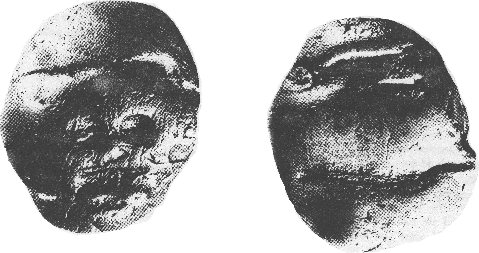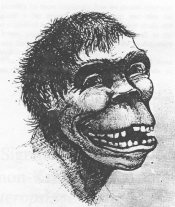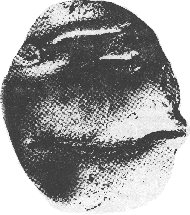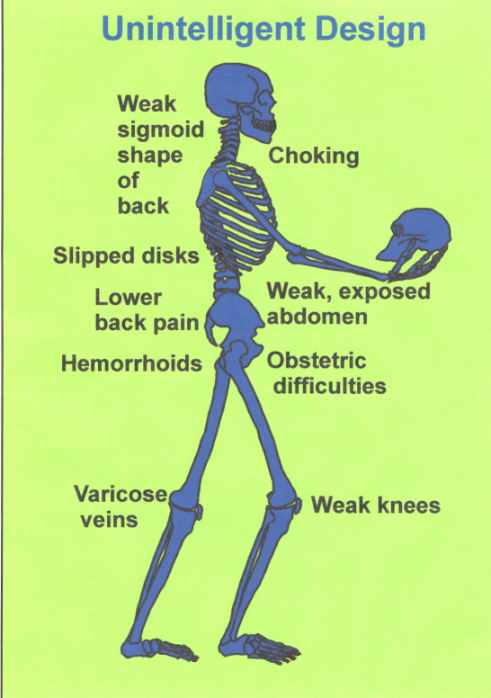|
A Critique of the "Intelligent
Design" Proposition,
or Searching for Design and Finding Evolution. by J.K. McKee |
+
|
| The Riddled Chain | PEER into your past! | J K McKee's contact & credentials |
| Evolution FAQs and OGAs | Creationist Contradictions |
|
A Critique of the "Intelligent
Design" Proposition,
or Searching for Design and Finding Evolution. by J.K. McKee |
+
|
Part III - Unintelligent Design
Look at the stone pebbles above. Each one portrays a face. They are two views of a single pebble that came from the Makapansgat limeworks ... a site famous for the Australopithecus africanus fossils dating to approximately 3-3.2 million years ago. The pebble may, or may not, have come from the Australopithecus deposits, Australopithecus being a likely ancestor of the human genus Homo. On the left is a face seen by a number of observers, and once considered the vanguard of primitive art ... a human face.
Intelligent Design of the rock? An early Mount Rushmore? Or just a product of chance?
Some could see the "design" in the pebble. They saw what they were looking for. Raymond Dart, who initially named Australopithecus, turned the pebble and saw a different face ... that of the fancifully reconstructed Australopithecus africanus. He too was deceived by the chance occurrences of nature and the wantings of the human mind.
| According to Dart, the face in the rock at right resembled the face in the picture at left. Dart inferred that Australopithecus recognized the face, and purposefully retrieved and transported the pebble. It is easy, even for some scientists, to conflate chance with design. |  |
 |
Then again, maybe Dart was right? If the rock was not the design of an individual, could the transport of the rock for artistic purposes be inferred? Maybe. Such a notion can be proposed, but not tested. It can be inferred, but not scientifically justified. We may never know.
The "Intelligent Design Proposition" is likewise an inference. Such a notion can be proposed, but not tested. It can be inferred, but not scientifically justified. It falls outside the realm of science, and like Dart's pebble, lies only in the imagination. Are either ideas necessarily wrong? No. But let's look into this further, from a scientific perspective.
Can evolution through natural selection be hypothetically proposed and scientifically tested? Yes, the tests come from fossil, genetic, and comparative data (morphology and physiology).
But can chance, coincidence, and chaos result in organized patterns? My answer is yes ... one can see that with the pebble with two faces. Two faces resulted from chance alone. Add some biological reproductive skills, and the non-design forces can produce wondrous things. That is what natural selection is all about. (And, I should add, what The Riddled Chain is all about).
The fact is that chance, coincidence, and chaos also have recognizable signatures. Those can be labeled, for purposes here, as "unintelligent design." The evolutionary process is abundantly clear in the "design" flaws of the human body. Each is inexplicable by any proposition of "design," but better understood by the compromising nature of the evolutionary process. Take a look:
 |
The human body consists of a series of compromises. In order to have become bipedal and have a large brain, our bodies contain uncomfortable remnants of the evolutionary process.
Under the "intelligent design proposition" one has at least three alternatives to explain the above "design" flaws: 1) The designer was inept (hardly consistent with creationist views that the designer was God); 2) The "designer" used an evolutionary process to create humans ( a view consistent with the presence of God); 3) The designer simply designed the process.
Like Dart's inference about the mind of Australopithecus in choosing the pebble that looked like a face, any of the above "intelligent design" propositions may be true ... but are outside the realm of science. Other propositions may be true as well, but in science we can only know what is testable. The rest is philosophy and religion.
Summary
I. Complexity is expected from natural processes.
II. "Irreducible complexity" applies to just about anything that moves, and can be easily explained through evolutionary processes. True irreducible complexity comes from either a) insufficient data, or b) a weakness of the mind.
III. There are many signatures of "unintelligent design" that negate the need or usefulness of an "intelligent design proposition."
Conclusion
"Intelligent Design" has yet to establish itself with any scientific validity. Not only is it logically inconsistent with the fossil evidence and other evidences for evolution, but ID has yet to propose a single testable hypothesis. Evolutionary theory, on the other hand, remains the cornerstone of modern biology.
| Evolution/Creation FAQs and OGAs | Creationists Contradictions |
| Home page | The Riddled Chain | PEER into your past! | J. K. McKee's credentials |